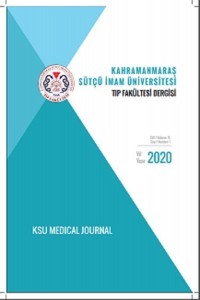GERİATRİK HASTALARDA FARKLI ÖLÇEKLER KULLANILARAK KIRILGANLIK PREVALANSININ BELİRLENMESİ
Geriatri, Kırılganlık, Prevalans
Determination of Frailty Prevalence by Using Discrete Measures Geriatric Patients in Clinic
Frailty, elderly, prevalance,
___
- Kaynaklar 1. Kinsella K, Wan H. U.S. Census Bureau: International Population Reports. An Aging World, Washington:2008. U.S. Government Printing Office, DC. 2009:1-209.
- 2. Cherniack EP, Florez HJ, Troen BR. Emerging therapies to treat frailty syndrome in the elderly. Altern Med Rev. 2007;12:246-258.
- 3. Fairhall N, Aggar C, Kurrle SE, Sherrington C, Lord S, Lockwood K, et al. Frailty Intervention Trial (FIT). BMC Geriatr. 2008;8:27.
- 4. Ülger Z, Arıoğlu S. Kırılgan Yaşlı. Geriatri ve Gerontoloji, Medikal Nobel Kitabevleri, İstanbul. 2006;385-391.
- 5. Aras S. Varlı M, Atlı T. Yaşlılıkta Kırılganlığı Anlamak, Akad Geriatri,2011; 3(3): 130-137.
- 6. Topinková E. Aging, disability and frailty. Ann Nutr Metab. 2008;52:6-11.
- 7. Fried LP, Tangen CM, Walston J, Newman AB, Hirsch C, Gottdiener J, et al. Cardiovascular Health Study Collaborative Research Group. Frailty in older adults: evidence for a phenotype. J Gerontol A Biol Sci Med Sci. 2001;56(3):146-157.
- 8. Bandeen-Roche K, Xue QL, Ferrucci L, Walston J, Guralnik JM, Chaves P, et al. Phenotype of frailty: characterization in the women's health and aging studies. Journal of Gerontology: Medical Sciences,2006; 3: 262-266.
- 9. Tavassoli N, Guyonnet S, Abellan Van Kan G, Sourdet S, Krams T, Soto ME, et al. Description of 1,108 older patients referred by their physician to the "Geriatric Frailty Clinic (G.F.C) for Assessment of Frailty and Prevention of Disability" at the gerontopole. Geriatric Frailty Clinic (G.F.C) for Assessment of Frailty and Prevention of Disability Team. J Nutr Health Aging. 2014;18(5):457-464.
- 10. Bandeen-Roche K, Seplaki CL, Huang J, Buta B, Kalyani RR, Varadhan R et al. Frailty in Older Adults: A Nationally Representative Profile in the United States. J Gerontol A Biol Sci Med Sci. 2015;70(11):1427-1434.
- 11. Bennett JA, Winters-Stone KM, Dobek J, Nail LM. Frailty in older breast cancer survivors: age, prevalence, and associated factors. Oncol Nurs Forum. 2013;40(3):126- 134.
- 12. Heppenstall, C. P. Maintaining Independence: Predicting and Preventing Residential Care Admission in Frail Older People Discharged from Hospital, A thesis for the degree of Doctor of Philosophy The University of Otago, Christchurch. 2011.
- ISSN: 1303-6610
- Yayın Aralığı: Yılda 3 Sayı
- Başlangıç: 2004
- Yayıncı: Kahramanmaraş Sütçü İmam Üniversitesi
Muhammet Mesut Nezir ENGİN, Nefise ARIBAŞ ÖZ, Yunus ŞENGÜN, Furkan TİMUR, Kenan KOCABAY
İNFLAMATUAR AĞRI MODELİNDE PLATİN-MELOKSİKAM METAL KOMPLEKSİNİN ANTİ-HİPERNOSİSEPTİF ETKİLERİ
Selma YAMAN, Seda AVNİOĞLU, Kübra KÜÇÜK, Derya ALAKUŞ, Büşra Nur DEMİRCİ, Harun MUSLU, Ayşegül GÖLCÜ, Tufan MERT
GERİATRİK HASTALARDA FARKLI ÖLÇEKLER KULLANILARAK KIRILGANLIK PREVALANSININ BELİRLENMESİ
Sedat ÖZDEMİR, Zeynel Abidin ÖZTÜRK, İbrahim Halil TÜRKBEYLER, Fikri ŞİRİN, Mehmet GÖL
İmmün Trombositopenik Purpura Etyolojisinde Brusella
Tuğba Kandemir GÜLMEZ, Hüsnü Maraşli MARAŞLI, Büşra SEĞMEN, Zübeyde DİNÇER, Can ACIPAYAM, Mehmet DAVUTOĞLU, Esra KAYA
KONVERSİYON BOZUKLUĞU OLAN HASTALARDA SEREBELLAR HACMİN SAĞLIKLI KONTROLLERLE KARŞILAŞTIRILMASI
Sema BAYKARA, Murad ATMACA, Hanefi YILDIRIM
